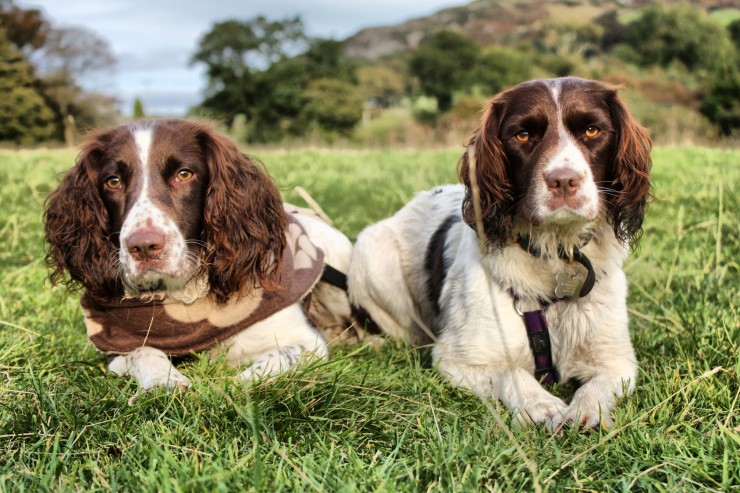
One of the most important skills you can teach your dog is self control. All too often I hear from people whose lives revolve around their dogs, in a way that’s not good for the people or the dogs.
If you’ve got a puppy, now is the time to start teaching self control. Well-meaning but misinformed dog owners think they are doing right by their puppy by attending to every whim and want of their puppy. They love their puppy so much that they forget to teach one of the most important doggie skills there is – self control.
WHAT IS SELF CONTROL?
You’ve probably seen it – dogs that bark incessantly until they get what they want. Or dogs who are so excited to greet visitors that they forget there’s someone on the other end of his leash and pulls the person down the street (or through the mud puddles). You may think it’s lovely that your puppy loves visitors so much that he runs and jumps on them to say Hello, but the reality of the situation is that you have a rude puppy.
WHY IS IT IMPORTANT?
Neglecting to teach our dogs this skill does them an enormous disservice. By not teaching our dogs this crucial skill, we actually limit their freedom in public. Dogs that cannot control themselves are bothersome to people and dogs alike. A dog that drags his owner down the road because “he’s just so friendly” or barks for attention isn’t cute, and the behavior shouldn’t be glossed over with excuses or explanations. Dogs deserve more credit – they are smart enough to learn self-control if the humans in their life take the time to teach them.
Don’t know if your dog has self-control issues? Describe your dog’s questionable behavior as if he were a person. Now that it’s phrased in “people terms” does it seem unreasonable? If it sounds shocking, then your dog could probably sharpen his self-control skills.
For example, do you have to play with your dog when he brings you a toy (or suffer the consequences such as barking, pawing, whining)? Would you think it a bit strange if a parent got up from the dinner table because Johnny wanted to go play baseball at that moment?
Does your dog go bonkers at the sight of other dogs because he’s so friendly and wants to play? And he drags you across the yard to get to the other dogs? Now rephrase that — Your ten-year-old sees her friend with her family and dashes across the street without looking (you in tow) because she just has to say Hello?
It’s never too late to teach your dog self control. Even older dogs can learn this skill. The longer the dog has practiced the behavior, however, the longer it will take to teach self-control. But self control is so important that it’s worth taking the time to teach it!
HOW TO TEACH SELF CONTROL
The first skill to teach your dog is to look at you; to pay attention to you. Next, teach your dog to sit as a way of requesting anything he wants. Before you do anything for your dog (petting, feeding, playing, going on a walk, etc.) request that they sit first. Not until they sit do they get to go outside, or get attention, or get dinner, or whatever it is that they want. Sitting is an easy task for most dogs, and it’s not asking too much for them to “say please” in this manner for something that they like.
A common mistake people make is letting their puppy do something “because it’s so cute.” Yes, it’s really cute when your little 8-week old puppy squirms and wiggles and jumps on your friends. But in a few short months, that puppy will be well on his way to being a full grown dog and what’s cute for a puppy can be disastrous when it’s a full grown dog.
Cute only lasts for a few months…the habits they develop as puppies can last a lifetime and the behaviors are no longer cute when your dog is an adult.
QUICK SOLUTIONS
If your dog barks at you to get your attention, simply turn away. Walk into another room if you have to. If your dog follows you and barks at you, go into another room and close the door. Don’t talk to him, look at him, or give him any attention until he stops barking.
If your dog brings a toy and thrusts it into your lap to get you to play, ignore him and his attempts to solicit play. Go into another room if you need to. If he follows you with the toy, simply take the toy away and put it out of his reach. If he goes to find another one, take that one away, as well.
If your dog pulls to get to another person or dog, keep your hands close to your body (so the leash is consistently the same length) and stand as still as a tree. No conversation, no yanking on the leash, just be quiet and still. When you get some slack in the leash or when your dog turns to look at you, THEN say “good boy” and continue to move forward. If your dog doesn’t turn around at all, YOU turn around walk away (still holding onto the dog’s leash) from the person or dog that your dog finds so interesting.
Once you have taught your dog self-control, you’ll look back and wonder how you ever got along without it! It’s that powerful – it will change the interaction that you have with your dog in a positive way. Your dog will be afforded more freedom to go out in public, which is more fun for the both of you!
Laurie Luck
Smart Dog University, LLC
Certified Pet Dog Trainer (CPDT)
Association of Pet Dog Trainers, Member 3335
Box 1111
Mount Airy, MD 21771
http://smartdoguniversity.com
 Golden Retriever Puppies For Sale - What You Need To Look At?
Golden Retriever Puppies For Sale - What You Need To Look
Golden Retriever Puppies For Sale - What You Need To Look At?
Golden Retriever Puppies For Sale - What You Need To Look
 What A Cats Normal Temperature Should Be
What A Cats Norma
What A Cats Normal Temperature Should Be
What A Cats Norma
 What Is Lotus Syndrome In Dogs?
What Is Lotus Syn
What Is Lotus Syndrome In Dogs?
What Is Lotus Syn
 Ten Tips For Dealing With A Begging Dog
Ten Tips For Deal
Ten Tips For Dealing With A Begging Dog
Ten Tips For Deal
 Canine Tail Docking - The Law In The Uk
Canine Tail Docki
Canine Tail Docking - The Law In The Uk
Canine Tail Docki
Copyright © 2005-2016 Pet Information All Rights Reserved
Contact us: www162date@outlook.com